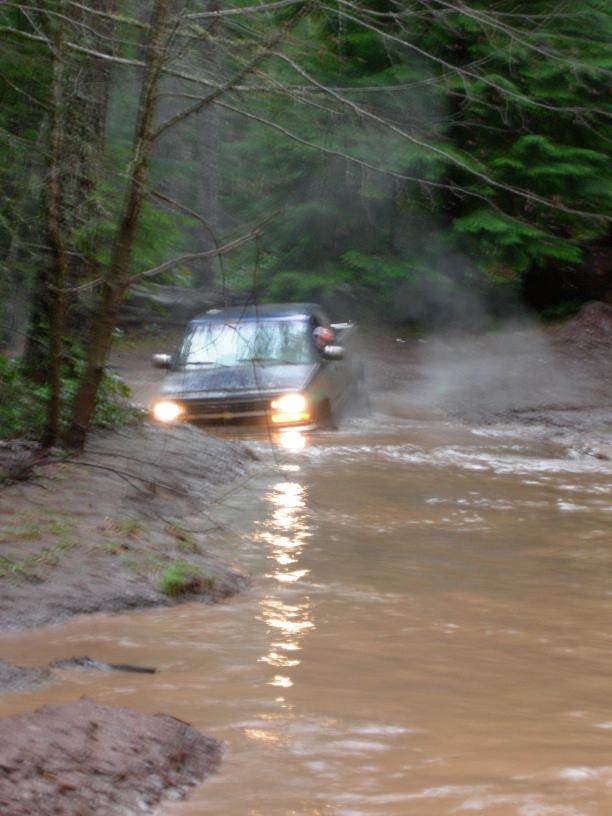No Whisky
Ultimately, with the backing of over 5,000 members, 800 letters from Oregonians, and field data from dozens of Groundtruthers, Bark was able to negotiate with the Forest Service and -Saved 335 acres of forest from being logged, including all of the native mature forest -Increased no-cut " stream buffers to protect water quality -Stopped the Forest Service from facilitating more off-road vehicle abuse and-Brokered a deal to ensure that money from logging will be used to restore areas destroyed by off-roaders.For more information on the No Whisky Timber Sale click the link below. "
- Bark saves 335 acres of forest from No Whisky Timber Sale!
 Negotiations also led to a plan to decrease off-road vehicle abuse in the Clackamas River watershed
Negotiations also led to a plan to decrease off-road vehicle abuse in the Clackamas River watershed
More...
General Info
- District: Clackamas
- Total Acres: 1647
- Watershed: North Fork Clackamas
- Sub-Watersheds: Lower Clackamas TributariesBedford CreekWinslow CreekUpper and Lower North Fork Clackamas
- Basic Location: Clackamas River Highway to 4610, north of 4610
- Driving Directions: Clackamas River Highway to 4610, north of 4610
- Legal Description: T4S, R5E sect. 13, 15-17, 20-28, 35 T4S, R6E sect. 19, 20, 22, 29 and 30
- Old Growth Units: Old growth unknown. Sale covers many acres. Bark needs help looking.
- Total MMBF: 20
Timber Sales
- 1929 (1647 Acres, 20 MMBF)
Sold on Aug-08-2006
Status: Logging - Cold
Sold on Aug-08-2006
Status: Sold, but not logged - Thunder Thin #2
Sold on Nov-01-2006
Status: Sold, but not logged - Dry Thin Stewardship
Sold on Feb-01-2007
Status: Sold, but not logged - Shay Thin Stewardship
Sold on Feb-01-2007
Status: Post Appeal/Ready to be Auctioned
Prescriptions
- Total Commercial Thin Acres: 1678
- Total Riparian Acres: 45
- "Purpose & Need:" Sell trees to be logged, thin to maximize future logging, make tree spacing less uniform by logging, grow bigger trees in Riparian Reserves by logging.
- Bark's Comments: All units either border or enter riparian reserves.
Roads
- Road Comments: Road density in this area exceeds Forest Service guidelines. Many temporary and closed 'roads continue to be used long after the Forest Service attempts to close them causing further damage for many years to come. Illegal usage of OHVs (off-highway vehicles) is rampant even in closed and roadless areas causing erosion, weeds, washouts, sediment deposition, noise and plant destruction. In 2002 Bark field surveys showed 26 of supposedly closed roads failed to keep out motorized vehicles.Most importantly the project area contains over 1000 acres of uninventoried roadless areas. Roadless areas are rare in Mt. Hood National Forest and provide valuable reserves for forest wildlife. Logging or road-building operations in these areas will undoubtedly inflict more harm than restoration in the project area.'
- Reconstruction Miles: 4.5
- Temporary Miles: 1.5
Habitat & Species
- S&M Species: aquatic molluskpine martin Cope 's giant salamanderOregon spotted frog
- T&E Species: Northern Spotted OwlPileated Woodpeckerdown stream of project area Columbia River Bull Trout, Lower Columbia River Steelhead, Upper Willamette River Chinook Salmon, Lower Columbia River Chinook, Lower Columbia River Coho SalmonPeregrine falcon
- Other Species: deerelkcoyote
- Additional Species Info: Designated critical habitat for Upper Willamette River chinook, Lower Columbia River steelhead, and Lower Columbia River chinook occur downstream of the No Whiskey Project in the mainstem Clackamas River and the North Fork Clackamas River.Oregon spotted frog, Cope 's giant salamander and peregrine falcon are three sensitive species likely to be affected by the project.
Restrictions
- 11/1 5/31 : off-road equipment. Restricted Units: 6, 7, 8, 9
- 1/15 7/31 : ambient noise restrictions (waivable after 6/30) . Restricted Units: 6, 7, 8, 9
- 1/15 7/31 : no helicopter below 1500 '. Restricted Units: units 1-14, 34-40
Updated 5/7/09








































